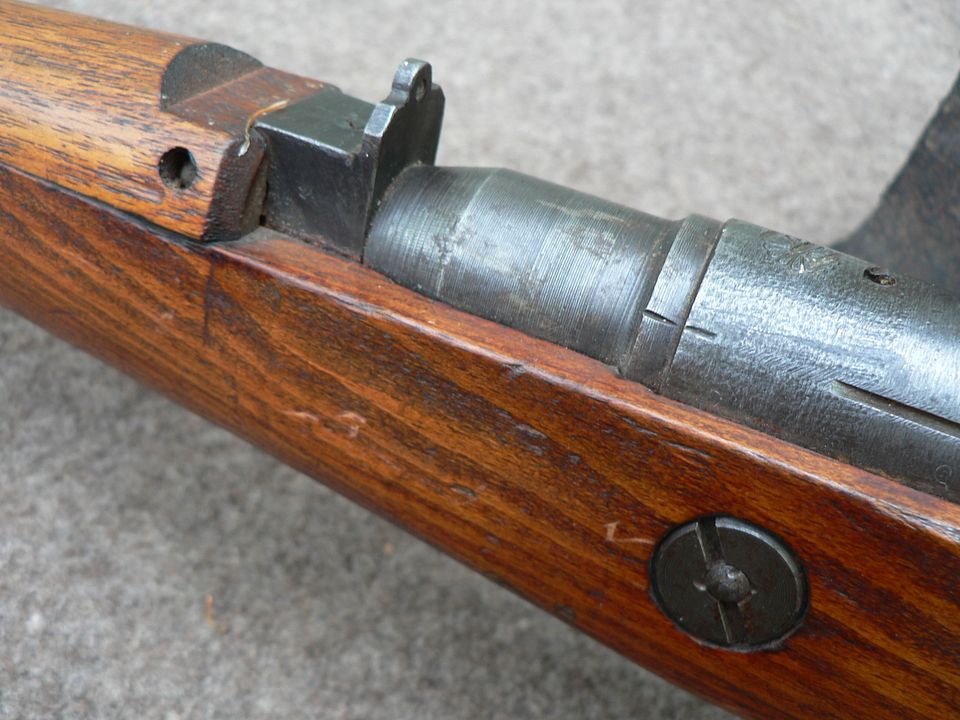Combloc
Stop Negassing me!!!!!
This old jobber came my way today. I'm generally not a bolt action guy and I'll probably move it along but I couldn't pass this up for fear of what someone might do to it. It's hard to read the kanji in front of the serial number but it looks to be a series 10 rifle. Whatever the case, it's a Nagoya manufactured late war Type 99 rifle and it's dry as a bone from sitting in storage somewhere for unknown decades. I'd like to leave it 100% untouched but there are a few places where it's starting to rust and the steel really needs to be protected before it starts to pit. I'll leave the stock alone as it seems stable. So, lets take a look at it before I break out the Eezox and give the steel a rub down.
It's a typical late war Type 99, nothing special but non-import marked and, save for the defaced mum, unmolested. It deserves to be preserved.

By the time this example was built, things were looking pretty rough for the Empire and they needed rifles ASAP so pretty bluing, finely finished parts, and superfluous features were long out the window. A perfect example of this is the front sight:

The protective ears have been omitted and the bluing is so thin as to be almost nonexistent.
Note the attachment pin and the rough finish of the base:

Here's an example of why we need to break out the Eezox:

It's minor and should clean right up but, left untreated, it's going to end up badly.
The permanently fixed in place front band shows the handiwork of a master! :


The rear band is the intersection of all three parts of the stock:

To the front of it (right side of picture) is the forearm. Behind is the main body of the stock and the handguard.
Left side of rear band showing sling swivel and end of band affixing screw:

Earlier models of the Type 99 had a monopod attached to this band.
Botton of rear band showing the ever so fine weld which gives this away as a stamped part:

The earlier elaborate rear sight with its funky fold out anti-aircraft wings is long gone. Now you just get a non-adjustable aperture:

Note all the old dust and funk in the nooks and crannies. Ewwwww......
Left side of rear sight:

Also seen in this picture is the barrel to receiver timing mark.
Top of rear sight showing what I am assuming is its mounting screw:

I'm by no means an Arisaka rifle expert! So, if this screw has another purpose, please enlighten me please.
Magazine floor plate showing the beginnings of rust that will need to go away:

To the left of frame is one of three screws used to hold the action in the stock. If you look carefully, you'll see two peen marks to lock the crew in place. All three screws are like this so the only way you're getting this thing apart is to muck up the peening and/or the screws. Obviously, that's not going to happen so I can't show you the action disassembled from the stock. Whatever bits of interesting detail are hiding in there will have to remain a mystery; sorry about that. The bottom of the trigger guard looks like it's pitted but it's not. It was stamped from rough steel band that was never polished. You see this kind of thing on lots of WWII era Soviet firearms too.
You see that rough steel on the rear tang too:

What looks like pitting is actually just roughness in the unpolished steel. When you run your finger over it, it's quite bumpy! Also note the poorly ground weld on the back of the safety knob. On early examples, this area sported a nicely machined chrysanthemum to both dress the weld and provide grip for your thumb when applying the safety. Now, its just rough ground.
The bolt handle has been given only the minimum finishing too:

Once again, the roughness is not pitting but just a lack of finishing.
Fortunately, the "mum" on this rifle was not ground off so it is still useful as reference for future research. However, it was defaced by several chisel or scratch marks:

This tells us the rifle was not captured in battle but instead brought back to the United States as war booty.
This rifle exhibits the late pattern, single screw rear swivel:

By this point, they were trying anything and everything to save a little steel and manufacturing time. Eventually, the swivel would be eliminated entirely and replaced by a simple hole drilled through the stock for the attachment of what collectors call a "rope sling".
The steel butt plate was also omitted and replaced with a wooden butt plate simple nailed in place:

The remains of the sticker are not original. I don't know why this now destroyed sticker was applied or when but I can tell you that a guy named Thomas had something to do with it! I'll leave it as is.
The front of the forend is a simple tongue that plugs into the front band. No provision was made for a cleaning rod:

It's a typical late war Type 99, nothing special but non-import marked and, save for the defaced mum, unmolested. It deserves to be preserved.
By the time this example was built, things were looking pretty rough for the Empire and they needed rifles ASAP so pretty bluing, finely finished parts, and superfluous features were long out the window. A perfect example of this is the front sight:
The protective ears have been omitted and the bluing is so thin as to be almost nonexistent.
Note the attachment pin and the rough finish of the base:
Here's an example of why we need to break out the Eezox:
It's minor and should clean right up but, left untreated, it's going to end up badly.
The permanently fixed in place front band shows the handiwork of a master! :
The rear band is the intersection of all three parts of the stock:
To the front of it (right side of picture) is the forearm. Behind is the main body of the stock and the handguard.
Left side of rear band showing sling swivel and end of band affixing screw:
Earlier models of the Type 99 had a monopod attached to this band.
Botton of rear band showing the ever so fine weld which gives this away as a stamped part:
The earlier elaborate rear sight with its funky fold out anti-aircraft wings is long gone. Now you just get a non-adjustable aperture:
Note all the old dust and funk in the nooks and crannies. Ewwwww......
Left side of rear sight:
Also seen in this picture is the barrel to receiver timing mark.
Top of rear sight showing what I am assuming is its mounting screw:
I'm by no means an Arisaka rifle expert! So, if this screw has another purpose, please enlighten me please.
Magazine floor plate showing the beginnings of rust that will need to go away:
To the left of frame is one of three screws used to hold the action in the stock. If you look carefully, you'll see two peen marks to lock the crew in place. All three screws are like this so the only way you're getting this thing apart is to muck up the peening and/or the screws. Obviously, that's not going to happen so I can't show you the action disassembled from the stock. Whatever bits of interesting detail are hiding in there will have to remain a mystery; sorry about that. The bottom of the trigger guard looks like it's pitted but it's not. It was stamped from rough steel band that was never polished. You see this kind of thing on lots of WWII era Soviet firearms too.
You see that rough steel on the rear tang too:
What looks like pitting is actually just roughness in the unpolished steel. When you run your finger over it, it's quite bumpy! Also note the poorly ground weld on the back of the safety knob. On early examples, this area sported a nicely machined chrysanthemum to both dress the weld and provide grip for your thumb when applying the safety. Now, its just rough ground.
The bolt handle has been given only the minimum finishing too:
Once again, the roughness is not pitting but just a lack of finishing.
Fortunately, the "mum" on this rifle was not ground off so it is still useful as reference for future research. However, it was defaced by several chisel or scratch marks:
This tells us the rifle was not captured in battle but instead brought back to the United States as war booty.
This rifle exhibits the late pattern, single screw rear swivel:
By this point, they were trying anything and everything to save a little steel and manufacturing time. Eventually, the swivel would be eliminated entirely and replaced by a simple hole drilled through the stock for the attachment of what collectors call a "rope sling".
The steel butt plate was also omitted and replaced with a wooden butt plate simple nailed in place:
The remains of the sticker are not original. I don't know why this now destroyed sticker was applied or when but I can tell you that a guy named Thomas had something to do with it! I'll leave it as is.
The front of the forend is a simple tongue that plugs into the front band. No provision was made for a cleaning rod:

